Numerical Study on Shear-Oriented Parameters in RC Beams with Openings Reinforced by Fe-SMA Rebars
Abstract
1. Introduction
2. Computational Framework for Finite Element Analysis
2.1. Structural Materials and Constitutive Modeling
2.1.1. Concrete Behavior Model
2.1.2. Steel Reinforcement Characteristics
2.1.3. Fe-SMA Mechanical Properties
2.2. Finite Element Discretization and Solution Approach
2.2.1. Element Selection and Mesh Refinement
2.2.2. Convergence Criteria and Solution Controls
2.3. Specimen Geometry and Reinforcement Configurations
3. Results and Discussion
3.1. The Validation of the Numerical Model
3.1.1. Comparison with Experimental Data
3.1.2. Assessment of Load-Deflection Behavior and Cracking Patterns
3.2. Parametric Investigation
3.2.1. Influence of Stirrup Spacing
3.2.2. Impact of Fe-SMA Stirrup Diameter
3.2.3. Effect of Horizontal Reinforcement
3.2.4. Crack Pattern
4. Conclusions
- Web openings reduced the ultimate load capacity of RC beams by up to 38% compared to solid beams.
- Reducing the Fe-SMA stirrup spacing from 400 mm to 200 mm and 100 mm at a fixed 8 mm stirrup diameter partially restored the load capacity by 81% and 83%, respectively.
- Increasing the stirrup diameter from 8 mm to 12 mm and 16 mm at a fixed 400 mm spacing partially recovered 89% and 93%, respectively, of the solid beam’s capacity.
- Strengthening 160 × 160 mm2 openings with a horizontal Fe-SMA reinforcement, combined with larger stirrup diameters (increased from 8 mm to 16 mm), nearly restored the beam’s load-carrying capacity, achieving up to 95% of the solid beam’s original strength.
- Web openings disrupt the internal force flow and shear paths, resulting in a scattered crack pattern and a significantly reduced shear capacity.
- Reducing the Fe-SMA stirrup spacing improved crack control by confining cracks near the openings, while a wider spacing led to an increased crack density and propagation, weakening the compression strut mechanism.
- Increasing the stirrup diameter improved the mechanical interlock and confinement, leading to a reduced crack density and propagation, even when the spacing remained constant.
- Horizontal reinforcement played a key role in controlling the crack propagation, delaying strength degradation, and improving the structural integrity.
- Optimizing the configuration and placement of the shear reinforcement is essential for ensuring a safe and durable performance in RC beams with web openings.
Author Contributions
Funding
Data Availability Statement
Acknowledgments
Conflicts of Interest
References
- Golham, M.A.; Al-Ahmed, A.H.A. Behavior of GFRP reinforced concrete slabs with openings strengthened by CFRP strips. Results Eng. 2023, 18, 101033. [Google Scholar] [CrossRef]
- Hawileh, R.A.; El-Maaddawy, T.A.; Naser, M.Z. Nonlinear finite element modeling of concrete deep beams with openings strengthened with externally-bonded composites. Mater. Des. 2012, 42, 378–387. [Google Scholar] [CrossRef]
- Irmawan, M.; Piscesa, B. Performance of a Steel Fiber Reinforced Concrete Deep Beam with an Opening: A Non-linear Finite Element Analysis. In International Civil Engineering and Architecture Conference; Springer: Berlin/Heidelberg, Germany, 2024; pp. 359–368. [Google Scholar]
- Zeytinci, B.M.; Şahin, M.; Güler, M.A.; Tsavdaridis, K.D. A practical design formulation for perforated beams with openings strengthened with ring type stiffeners subject to Vierendeel actions. J. Build. Eng. 2021, 43, 102915. [Google Scholar] [CrossRef]
- Lawson, R.M.; Basta, A. Deflection of C section beams with circular web openings. Thin-Walled Struct. 2019, 134, 277–290. [Google Scholar] [CrossRef]
- Mohammed, M.Y.; Ali, A.Y.; Kadhim, M.M.A.; Jawdhari, A. RC deep beams with vertical openings: Behavior and proposed mitigation techniques. Pract. Period. Struct. Des. Constr. 2024, 29, 04023060. [Google Scholar] [CrossRef]
- Zuaiter, M.; El-Hassan, H.; El-Maaddawy, T. Shear behavior of glass fiber-reinforced slag-fly ash blended geopolymer concrete beams. Constr. Build. Mater. 2025, 466, 1. [Google Scholar] [CrossRef]
- Bolina, F.L.; Fisch, G.; Silva, V.P.E. RC beams with rectangular openings in case of fire. Rev. IBRACON De Estrut. E Mater. 2023, 16, e16206. [Google Scholar] [CrossRef]
- Attom, M.; El-Kadri, O.; Khalil, A. Optimization of Geothermal Energy Piles Design Parameters to Enhance Thermal Efficiency. In Proceedings of the 2024 5th International Conference on Clean and Green Energy Engineering (CGEE), Izmir, Turkey, 24–26 August 2024; IEEE: New York, NY, USA, 2024; pp. 83–87. [Google Scholar]
- Khalil, A.; Attom, M.; Khan, Z.; Astillo, P.V.; El-Kadri, O.M. Recent Advancements in Geothermal Energy Piles Performance and Design. Energies 2024, 17, 3386. [Google Scholar] [CrossRef]
- Farouk, M.A.; Moubarak, A.M.R.; Ibrahim, A.; Elwardany, H. New alternative techniques for strengthening deep beams with circular and rectangular openings. Case Stud. Constr. Mater. 2023, 19, e02288. [Google Scholar] [CrossRef]
- Galustanian, N.; El-Sisi, A.; Amer, A.; Elshamy, E.; Hassan, H. Review of the Structural Performance of Beams and Beam–Column Joints with Openings. CivilEng 2023, 4, 1233–1242. [Google Scholar] [CrossRef]
- Jagan, P.; Visuvasam, J.A. Assessment of dynamic soil-structure interaction effects on floating column structures with reinforced geotechnical isolation and shear wall system. Mech. Adv. Mater. Struct. 2025, 1–17. [Google Scholar] [CrossRef]
- Najar, I.A.; Ahmadi, R.; Amuda, A.G.; Mourad, R.; Bendary, N.E.; Ismail, I.; Bakar, N.A.; Tang, S. Advancing soil-structure interaction (SSI): A comprehensive review of current practices, challenges, and future directions. J. Infrastruct. Preserv. Resil. 2025, 6, 5. [Google Scholar] [CrossRef]
- Khalil, A.; Khan, Z.; Attom, M.; Fattah, K.; Ali, T.; Mortula, M. Continuous Evaluation of Shear Wave Velocity from Bender Elements during Monotonic Triaxial Loading. Materials 2023, 16, 766. [Google Scholar] [CrossRef]
- Khalil, A.; Khan, Z.H.; Attom, M.; El Emam, M.; Fattah, K. Dynamic properties of calcareous sands from urban areas of Abu Dhabi. Appl. Sci. 2022, 12, 3325. [Google Scholar] [CrossRef]
- Khalil, A.; Khan, Z.; Attom, M.; Khalafalla, O. Evaluation of Ground Improvement with Dynamic Replacement and Rapid Impact Compaction of an Artificial Island in the UAE—A Case Study. In Geo-Congress; ASCE: Reston, VA, USA, 2024; pp. 116–125. [Google Scholar] [CrossRef]
- Shakir, Q.M.; Al-Tameemi, H.A.; Kamonna, H.H.H. Effect of Opening Characteristics on the Performance of High Strength Rc Dapped-End Beams. J. Eng. Sci. Technol. 2020, 15, 693–708. [Google Scholar]
- Alyaseen; Poddar, A.; Alissa, J.; Alahmad, H.; Almohammed, F. Behavior of CFRP-strengthened RC beams with web openings in shear zones: Numerical simulation. Mater. Today Proc. 2022, 65, 3229–3239. [Google Scholar] [CrossRef]
- Abed, F.; Oucif, C.; Awera, Y.; Mhanna, H.H.; Alkhraisha, H. FE modeling of concrete beams and columns reinforced with FRP composites. Def. Technol. 2021, 17, 1–14. [Google Scholar] [CrossRef]
- Alkhraisha, H.; Mhanna, H.; Abed, F. FE Modeling of RC Beams Reinforced in Flexure with BFRP Bars Exposed to Harsh Conditions. In Sustainable Issues in Infrastructure Engineering: The official 2020 Publication of the Soil-Structure Interaction Group in Egypt (SSIGE); Springer: Berlin/Heidelberg, Germany, 2021; pp. 3–13. [Google Scholar]
- Alkhraisha, H.; Abed, F. Impact of exposing GFRP bars to humid environments on the behavior of GFRP RC beams. Mater. Today Proc. 2023. [Google Scholar] [CrossRef]
- Elkafrawy, M.; Khalil, A.; AlHamaydeh, M.; Hawileh, R.; Abuzaid, W. Enhancing the Shear Capacity of RC Beams with Web Openings in Shear Zones Using Pre-Stressed Fe-SMA Bars: Numerical Study. Buildings 2023, 13, 1505. [Google Scholar] [CrossRef]
- Zuaiter, M.; Khalil, A.; Elkafrawy, M.; Hawileh, R.; AlHamaydeh, M.; Ayman, A.; Kim, T.-Y. Effect of blending GGBS and silica fume on the mechanical properties of geopolymer concrete. Sci. Rep. 2025, 15, 9091. [Google Scholar] [CrossRef]
- Zeyad, A.M. Sustainable concrete Production: Incorporating recycled wastewater as a green building material. Constr. Build. Mater. 2023, 407, 133522. [Google Scholar] [CrossRef]
- Bonoli, A.; Zanni, S.; Serrano-Bernardo, F. Sustainability in building and construction within the framework of circular cities and european new green deal. The contribution of concrete recycling. Sustainability 2021, 13, 2139. [Google Scholar] [CrossRef]
- Hamada, H.M.; Abed, F.; Hassan, A. Combined effect of iron ore waste and basalt fiber with high-volume supplementary cementitious materials on the workability, strength, and microstructure of sustainable concrete. Constr. Build. Mater. 2024, 444, 137679. [Google Scholar] [CrossRef]
- Elkafrawy, M.; Gowrishankar, P.; Aswad, N.G.; Alashkar, A.; Khalil, A.; AlHamaydeh, M.; Hawileh, R. GFRP-Reinforced Concrete Columns: State-of-the-Art, Behavior, and Research Needs. Buildings 2024, 14, 3131. [Google Scholar] [CrossRef]
- Khalil, A.; Hawileh, R.A.; Attom, M. Exploring Strength of Straight and Bent GFRP Bars: Refinements to CSA S807: 19 Annex E. Spec. Publ. 2024, 360, 242–253. [Google Scholar]
- Zhang, A.; Zhu, H.; Dong, Z.; Yang, Z. Mechanical properties and durability of FRP-reinforced coral aggregate concrete structures: A critical review. Mater. Today Commun. 2023, 35, 105656. [Google Scholar] [CrossRef]
- Elhadi, M.; Selmi, A.; Raza, A.; Ahmed, B.; El Ouni, M.H.; Arshad, M. Experiments and analytical model for axial strength of FRP-reinforced reactive powder concrete circular columns under axial compression. Eng. Struct. 2024, 306, 117768. [Google Scholar] [CrossRef]
- Khalil, A.; Hawileh, R.; Attom, M. Investigating the Durability of Bent and Straight Glass Fiber Reinforced Polymer (GFRP) Rebars: Pilot Study. In Proceedings of the 9th International Conference on Civil, Structural and Transportation Engineering, ICCSTE, Toronto, ON, Canada, 13–15 June 2024. [Google Scholar]
- Shu, Y.; Qiang, X.; Jiang, X. Water immersion impact on the durability of Fe-SMA/steel joints used in reinforcement systems. In Structures; Elsevier: Amsterdam, The Netherlands, 2025; p. 107922. [Google Scholar]
- Shu, Y.; Qiang, X.; Jiang, X.; Wang, F. Durability of Fe-SMA/steel single-lap joints exposed to hygrothermal environments. Constr. Build. Mater. 2024, 435, 136861. [Google Scholar] [CrossRef]
- Mustafa, F.; Ahmad, S.; Hassan, A.; Egilmez, M.; El-Khatib, S.; Ibrahim, T. Effect of Gd, V, and Y Alloying on the Corrosion Properties of Fe-Mn-Ni-Al Fe-based Shape Memory Alloy. In Journal of Physics: Conference Series; IOP Publishing: Bristol, UK, 2024; p. 012011. [Google Scholar]
- Santarsiero, G.; Picciano, V. Post-tension retrofitting of RC dapped-end beams: A numerical investigation. Struct. Concr. 2024, 25, 3246–3264. [Google Scholar] [CrossRef]
- Al-Salman, H.; Ali, Y.A.; Hassan, F.F.; Kadhim, M.A. Finite Element Approach to Simulate Performance of Multiple-Opening Reinforced Concrete Beams. Period. Eng. Nat. Sci. 2022, 10, 246–260. [Google Scholar] [CrossRef]
- Senthil, A.; Gupta, A.; Singh, S.P. Computation of stress-deformation of deep beam with openings using finite element method. Adv. Concr. Constr. 2018, 6, 245. [Google Scholar]
- Elsayed, A.; Badawy, S.; Tayeh, B.A.; Elymany, M.; Salem, M.; ElGawady, M. Shear behaviour of ultra-high performance concrete beams with openings. In Structures; Elsevier: Amsterdam, The Netherlands, 2022; pp. 546–558. [Google Scholar]
- Nie, X.; Zhang, S.; Gao, Z.; Zeng, Z. A review on the behaviour of reinforced concrete beams with fibre-reinforced polymer-strengthened web openings. Adv. Struct. Eng. 2022, 25, 426–450. [Google Scholar] [CrossRef]
- Zuaiter, M.; Kim, T.-Y.; Al-Rub, R.A.; Banat, F. Numerical Study on Flexural Response of Cement Mortars Fortified with Sustainable Graphene Derivative. In Proceedings of the 9th International Conference on Civil, Structural and Transportation Engineering, ICCSTE 2024, Toronto, ON, Canada, 13–15 January 2024. [Google Scholar] [CrossRef]
- Zuaiter, M.; Kim, T.-Y.; Banat, F.; Abualrub, R. Synergistic Impact of Sustainable Graphene Derivative and Dune Sand on Cement Mortars. In Proceedings of the 10th International Conference on Structural Engineering and Concrete Technology (ICSECT 2025), Barcelona, Spain, 13 April 2025. [Google Scholar] [CrossRef]
- Pohoryles, D.A.; Melo, J.; Rossetto, T.; Varum, H.; Bisby, L. Seismic retrofit schemes with FRP for deficient RC beam-column joints: State-of-the-art review. J. Compos. Constr. 2019, 23, 03119001. [Google Scholar] [CrossRef]
- Fang, C. SMAs for infrastructures in seismic zones: A critical review of latest trends and future needs. J. Build. Eng. 2022, 57, 104918. [Google Scholar] [CrossRef]
- Khalil, A.M.; Elkafrawy, M.; Hawileh, R.; Al-Hamaydeh, M. Numerical Investigation on Improving Shear Strength of RC Beams with Various Web Opening Shapes Using Pre-Stressed Fe-SMA Bars. Key Eng. Mater. 2024, 1004, 13–22. [Google Scholar] [CrossRef]
- Montoya-Coronado, L.A.; Ruiz-Pinilla, J.G.; Ribas, C.; Cladera, A. Experimental study on shear strengthening of shear critical RC beams using iron-based shape memory alloy strips. Eng. Struct. 2019, 200, 109680. [Google Scholar] [CrossRef]
- Qiang, X.; Liu, Q.; Chen, L.; Jiang, X.; Dong, H. Experimental study on flexural performance of prestressed concrete beams strengthened by Fe-SMA plates. Constr. Build. Mater. 2024, 422, 135797. [Google Scholar] [CrossRef]
- Choi, E.; Hu, J.W.; Lee, J.-H.; Cho, B.-S. Recovery stress of shape memory alloy wires induced by hydration heat of concrete in reinforced concrete beams. J. Intell. Mater. Syst. Struct. 2015, 26, 29–37. [Google Scholar] [CrossRef]
- Yeon, Y.-M.; Lee, W.; Hong, K.-N. Finite element analysis of reinforced concrete beams prestressed by Fe-based shape memory alloy bars. Appl. Sci. 2022, 12, 3255. [Google Scholar] [CrossRef]
- Qi, Z.; Zhou, Y.; Elchalakani, M. Machine Learning Applications in Building Energy Systems: Review and Prospects. Buildings 2025, 15, 648. [Google Scholar] [CrossRef]
- Banu, S.; Attom, M.; Abed, F.; Vandanapu, R.; Astillo, P.V.; Khalil, A.; Al-Lozi, N. Numerical analysis of the ultimate bearing capacity of strip footing constructed on sand-over-clay sediment. Buildings 2024, 14, 1164. [Google Scholar] [CrossRef]
- Attom, M.F.; Vandanapu, R.; Yamin, M.; Astillo, P.V.; Khalil, A.; Khan, Z.; Eltayeb, A. Prediction of internal erosion parameters of clay soils using initial physical properties. Water 2024, 16, 232. [Google Scholar] [CrossRef]
- Khalil, A.; Elkafrawy, M.; Hawileh, R.; AlHamaydeh, M.; Abuzaid, W. Numerical Investigation of Flexural Behavior of Reinforced Concrete (RC) T-Beams Strengthened with Pre-Stressed Iron-Based (FeMnSiCrNi) Shape Memory Alloy Bars. J. Compos. Sci. 2023, 7, 258. [Google Scholar] [CrossRef]
- Smith, M. ABAQUS/Standard User’s Manual, Version 6.9; Dassault Systèmes Simulia Corp: Johnston, RI, USA, 2009. [Google Scholar]
- Ji, S.-W.; Yeon, Y.-M.; Hong, K.-N. Shear performance of RC beams reinforced with Fe-based shape memory alloy stirrups. Materials 2022, 15, 1703. [Google Scholar] [CrossRef]
- Hong, K.-N.; Ji, S.-W.; Yeon, Y.-M. Predicting the shear behavior of reinforced concrete beams with Fe-Based shape memory alloy stirrups. Eng. Struct. 2023, 293, 116644. [Google Scholar] [CrossRef]
- Shahverdi, M.; Czaderski, C.; Motavalli, M. Iron-based shape memory alloys for prestressed near-surface mounted strengthening of reinforced concrete beams. Constr. Build. Mater. 2016, 112, 28–38. [Google Scholar] [CrossRef]
- Khalil, A.; Elkafrawy, M.; Abuzaid, W.; Hawileh, R.; AlHamaydeh, M. Flexural Performance of RC Beams Strengthened with Pre-Stressed Iron-Based Shape Memory Alloy (Fe-SMA) Bars: Numerical Study. Buildings 2022, 12, 2228. [Google Scholar] [CrossRef]
- Yang, R.; Zhan, C.; Fan, Y.; Xia, Y.; Wu, Y.; Yang, J. Characterizing the cracking features of seamless asphalt plug joint (SAPJ) under cooling process using ABAQUS and FE-SAFE. Constr. Build. Mater. 2025, 470, 140569. [Google Scholar] [CrossRef]
- Genikomsou, A.S.; Polak, M.A. Finite element analysis of punching shear of concrete slabs using damaged plasticity model in ABAQUS. Eng. Struct. 2015, 98, 38–48. [Google Scholar] [CrossRef]
- Thilak, M.; Kumar, S.R.S. An Assessment of the Appropriateness of a Gradient Damage Plasticity Model to Accurately Predict the Behaviour of Composite Beam-to-column Junctions. J. Inst. Eng. Ser. A 2025, 1–20. [Google Scholar] [CrossRef]
- Rainone, L.S.; Tateo, V.; Casolo, S.; Uva, G. About the use of concrete damage plasticity for modeling masonry post-elastic behavior. Buildings 2023, 13, 1915. [Google Scholar] [CrossRef]
- Hsu, L.S.; Hsu, C.-T.T. Complete stress—Strain behaviour of high-strength concrete under compression. Mag. Concr. Res. 1994, 46, 301–312. [Google Scholar] [CrossRef]
- Du Beton, E.-I. CEB-FIP MODEL CODE 1990: DESIGN CODE; Thomas Telford Publishing: London, UK, 1993. [Google Scholar]
- Shahverdi, M.; Czaderski, C.; Annen, P.; Motavalli, M. Strengthening of RC beams by iron-based shape memory alloy bars embedded in a shotcrete layer. Eng. Struct. 2016, 117, 263–273. [Google Scholar] [CrossRef]
- Saeedi, A.; Tabrizikahou, A.; Wagner, P.-R.; Shahverdi, M. Multiphysical simulation of iron-based shape memory alloy (Fe-SMA) activation embedded in concrete structures. Eng. Struct. 2025, 327, 119623. [Google Scholar] [CrossRef]
- Tabrizikahou; Kuczma, M.; Triantafyllidis, Z.; Shahverdi, M. Prestressing of concrete using iron-based shape memory alloy (Fe-SMA) short fibers: Experimental and numerical analysis. Constr. Build. Mater. 2025, 467, 140309. [Google Scholar] [CrossRef]
- Shu, Y.; Qiang, X.; Jiang, X.; Chen, W. Experimental study and design recommendations on Fe-SMA-steel bonded joints subjected to water immersion. Constr. Build. Mater. 2025, 461, 139875. [Google Scholar] [CrossRef]
- Lyu, Z.; Jiang, X.; Qiang, X. Experimental study on Fe-SMA strengthening technique for cope hole fatigue cracks in orthotropic steel bridge decks. Int. J. Fatigue 2025, 198, 109003. [Google Scholar] [CrossRef]
- Imjai, T.; Guadagnini, M.; Garcia, R.; Pilakoutas, K. A practical method for determining shear crack induced deformation in FRP RC beams. Eng. Struct. 2016, 126, 353–364. [Google Scholar] [CrossRef]
- Hu, B.; Wu, Y.-F. Quantification of shear cracking in reinforced concrete beams. Eng. Struct. 2017, 147, 666–678. [Google Scholar] [CrossRef]
- Setkit, M.; Leelatanon, S.; Imjai, T.; Garcia, R.; Limkatanyu, S. Prediction of Shear Strength of Reinforced Recycled Aggregate Concrete Beams without Stirrups. Buildings 2021, 11, 402. [Google Scholar] [CrossRef]
- Falih, A.; Al-Amli, A.S. Shear strengthened of RC hollow deep beams with large opening by plates: A Review. Al-Rafidain J. Eng. Sci. 2025, 3, 89–112. [Google Scholar]
- Ali, S.R.M.; Saeed, J.A. Shear capacity and behavior of high-strength concrete beams with openings. Eng. Struct. 2022, 264, 114431. [Google Scholar] [CrossRef]
- Youm, H.S.; Hong, S.G. Effects of Reinforcement Details on Shear Strength of Ultra-High-Performance Concrete (UHPC) Beams with Web Openings. J. Korea Concr. Inst. 2021, 33, 637–648. [Google Scholar] [CrossRef]
- Sayed, A.M. Numerical study using FE simulation on rectangular RC beams with vertical circular web openings in the shear zones. Eng. Struct. 2019, 198, 109471. [Google Scholar] [CrossRef]
- Zheng, W.; Hou, C. Calculation method of axial bearing capacity of confined concrete square columns. Jianzhu Jiegou Xuebao/J. Build. Struct. 2018, 39, 286–290. [Google Scholar] [CrossRef]
- Fu, L.; Yin, Q.; Wang, H.; Zhang, L.; Wang, D. Mechanism of influence of high-strength stirrup on shear performance of concrete beam. Eng. Mech. 2023, 40, 126–137. [Google Scholar]
- Callies, S.; Bogdan, L.; Islam, S. Value engineering of reinforcement used in large diameter drilled shafts. In Proceedings of the IFCEE 2018, Orlando, FL, USA, 5–10 March 2018; pp. 181–189. [Google Scholar] [CrossRef]
- Wang, Q.; Qin, W.; Lu, C. Effects of large-diameter rebar replacement on seismic behavior of precast concrete columns with grouted sleeve connections. Buildings 2023, 13, 706. [Google Scholar] [CrossRef]
- Lee, J.-Y.; Choi, S.-H.; Lee, D.H. Structural behaviour of reinforced concrete beams with high yield strength stirrups. Mag. Concr. Res. 2016, 68, 1187–1199. [Google Scholar] [CrossRef]
- Dilger, W.H. Inclined Stirrups and Inclined Stud Shear Reinforcement in Zones of High Shear. Spec. Publ. 2017, 321, 10–11. [Google Scholar]
- Aykac, B.; Aykac, S.; Kalkan, I.; Dundar, B.; Can, H. Flexural behavior and strength of reinforced concrete beams with multiple transverse openings. ACI Struct. J. 2014, 111, 267–278. [Google Scholar]
- Tung, D.; Betschoga, C.; Tue, N.V. Analysis of the crack development and shear transfer mechanisms of reinforced concrete beams with low amounts of shear reinforcement. Eng. Struct. 2020, 222, 111114. [Google Scholar] [CrossRef]
- Abdulkareem, Z.; Oukaili, N.; Al-Mahaidi, R. Efficiency of self-prestressing Fe-based shape memory alloys on shear strengthening of high-strength RC beams: Experimental and numerical investigation. In Structures; Elsevier: Amsterdam, The Netherlands, 2024; p. 106317. [Google Scholar]
- Chen, C.; Fang, H.; Lim, Y.M.; Xie, H.; Chen, J.; Park, J.W. Experimental and numerical studies on compressive behavior of winding FRP grid spiral stirrups confined circular concrete columns. Compos. Part A Appl. Sci. Manuf. 2025, 191, 108709. [Google Scholar] [CrossRef]
- Wu, C.; Hwang, H.-J.; Ma, G. Effect of stirrups on the bond behavior of lap spliced GFRP bars in concrete beams. Eng. Struct. 2022, 266, 2022. [Google Scholar] [CrossRef]
- Liu, C.; Xu, D. Shear strength investigation of concrete girders with proposed horizontal shear reinforcements in webs. In Proceedings of the 2010 Large Structures and Infrastructures for Environmentally Constrained and Urbanised Areas, Venice, Italy, 22–24 September 2010; pp. 560–561. [Google Scholar] [CrossRef]
- Xu, D.; Zhao, Y.; Liu, C. Experimental study on shear behavior of reinforced concrete beams with web horizontal reinforcement. Front. Struct. Civ. Eng. 2014, 8, 325–336. [Google Scholar] [CrossRef]
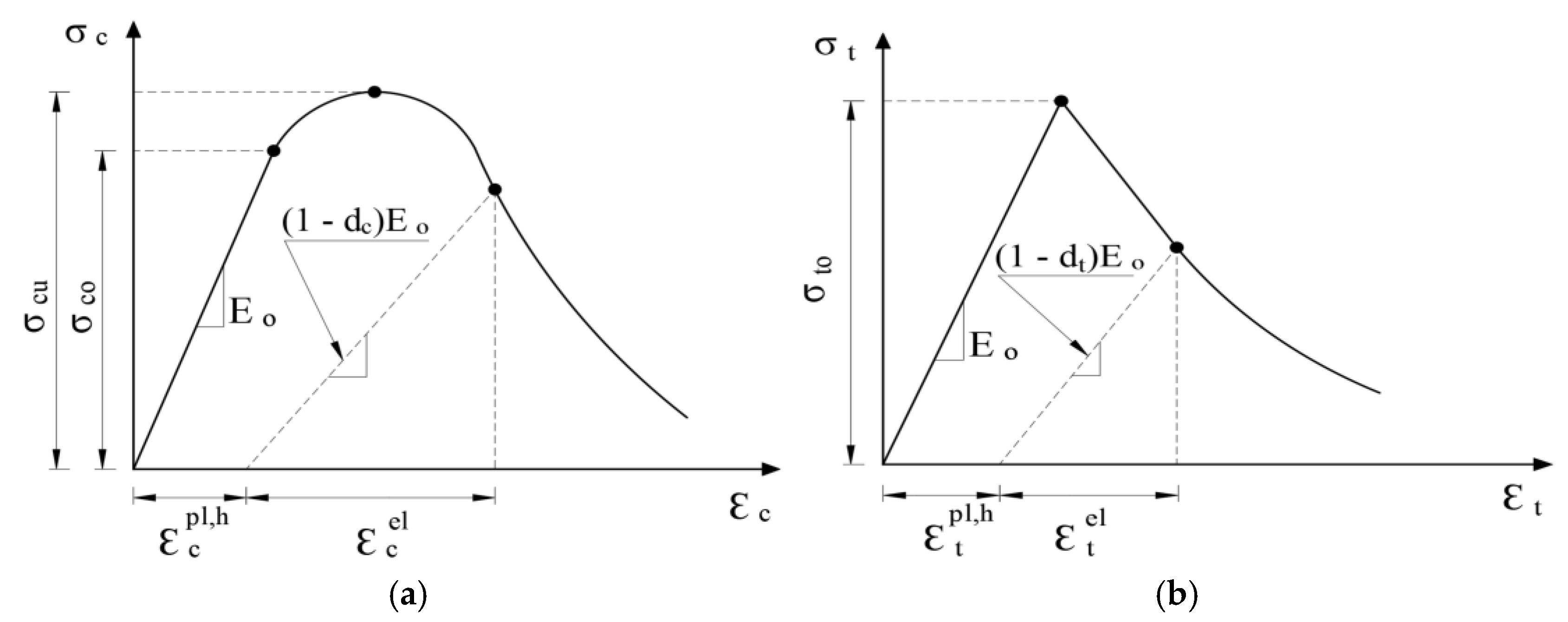
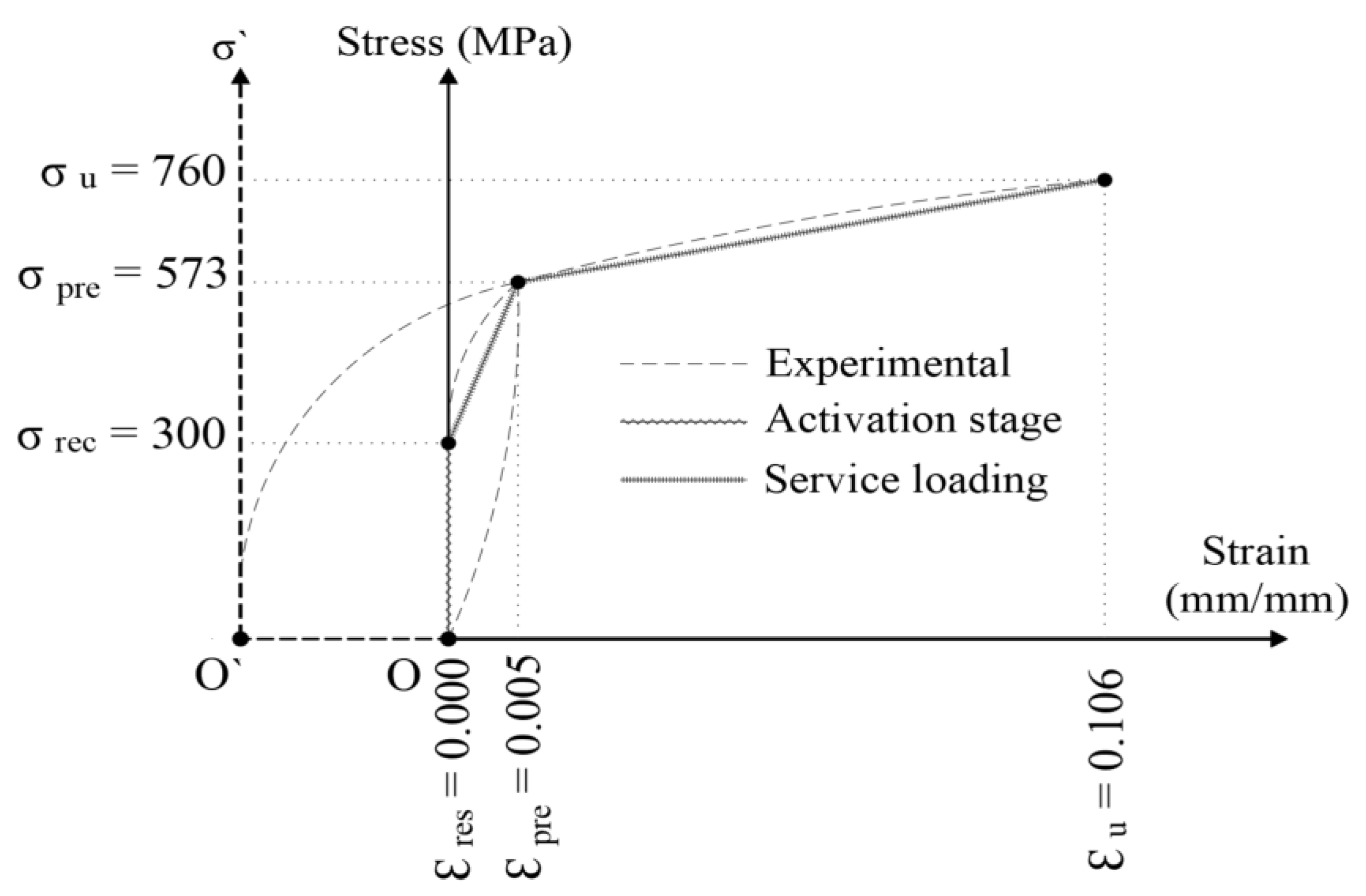
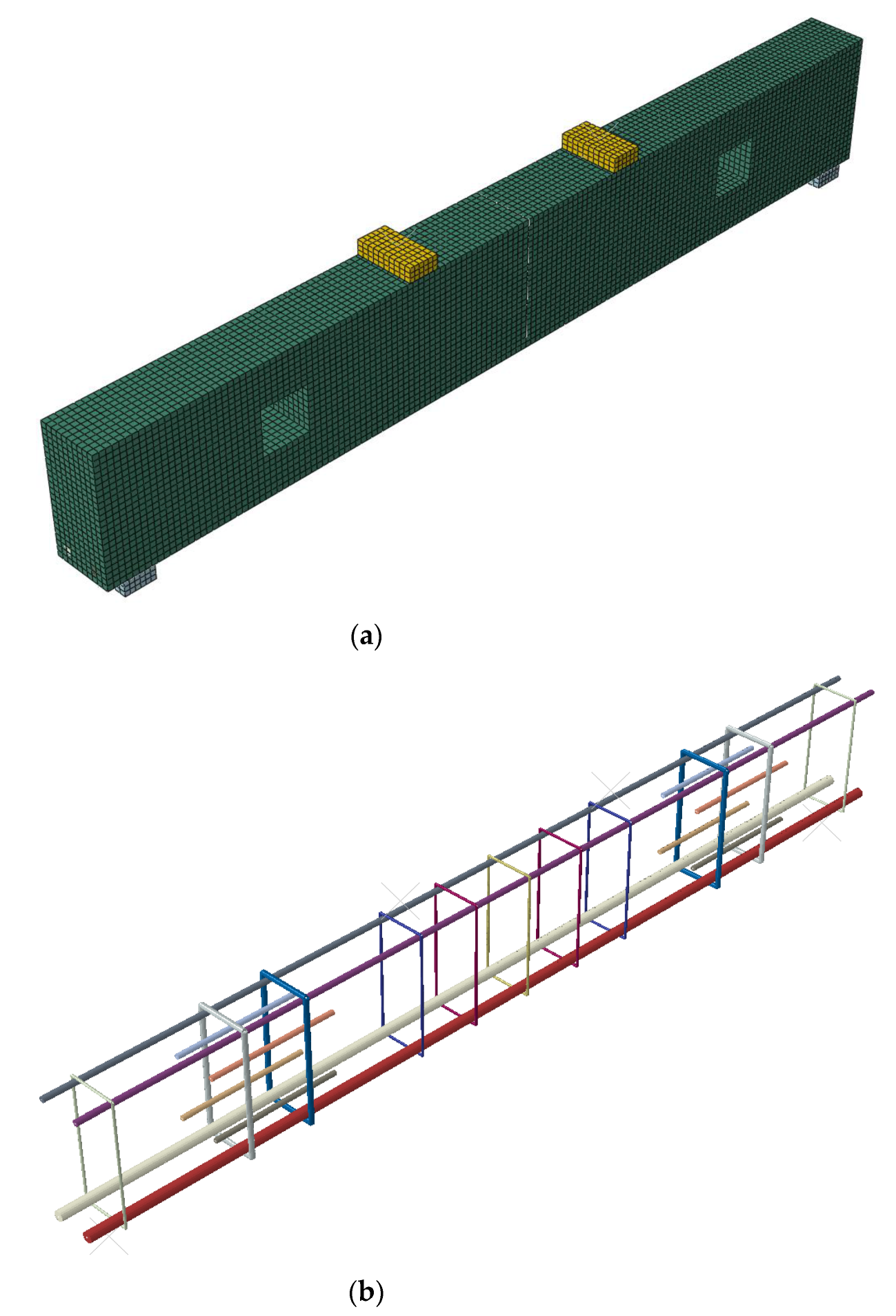


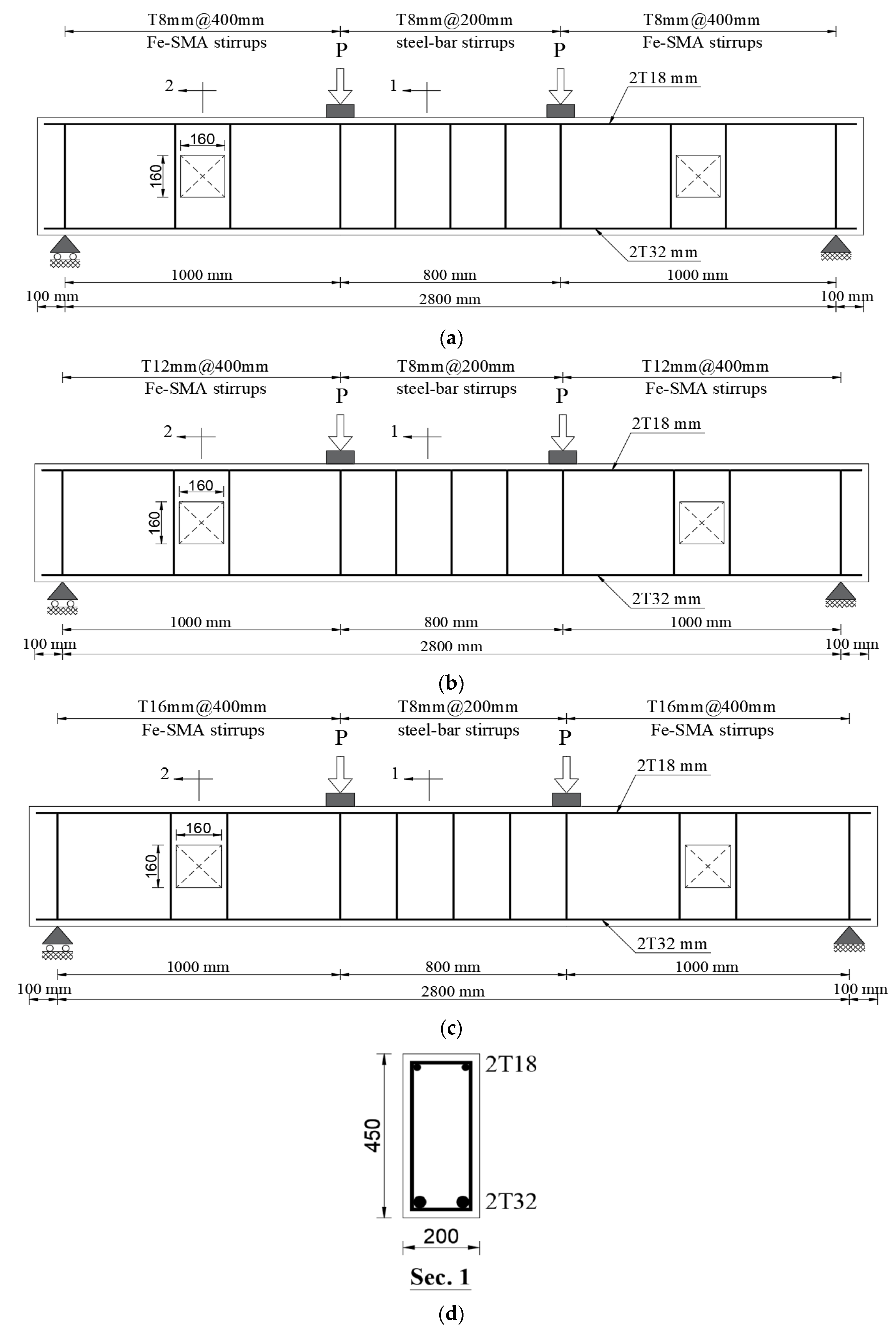
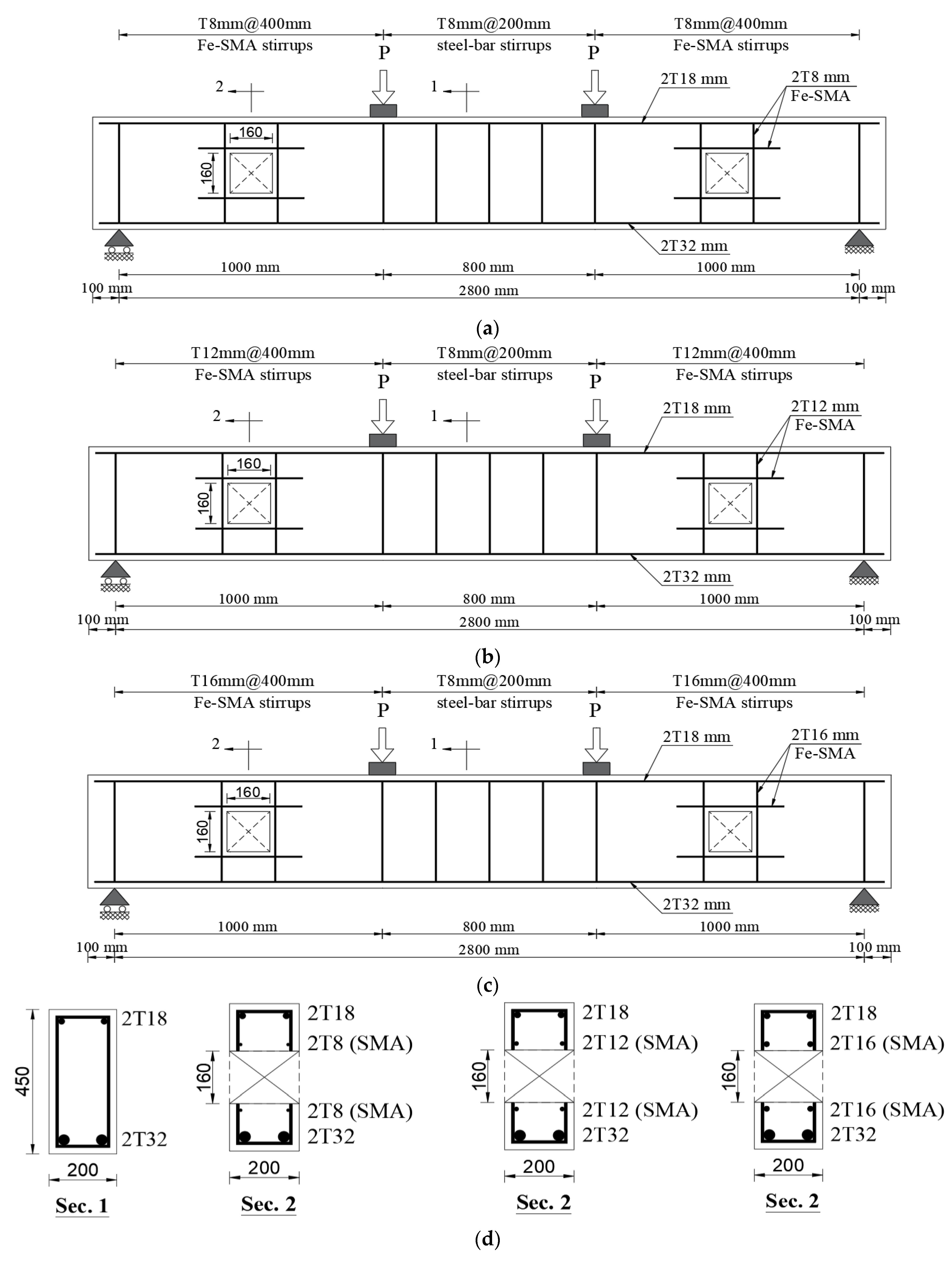
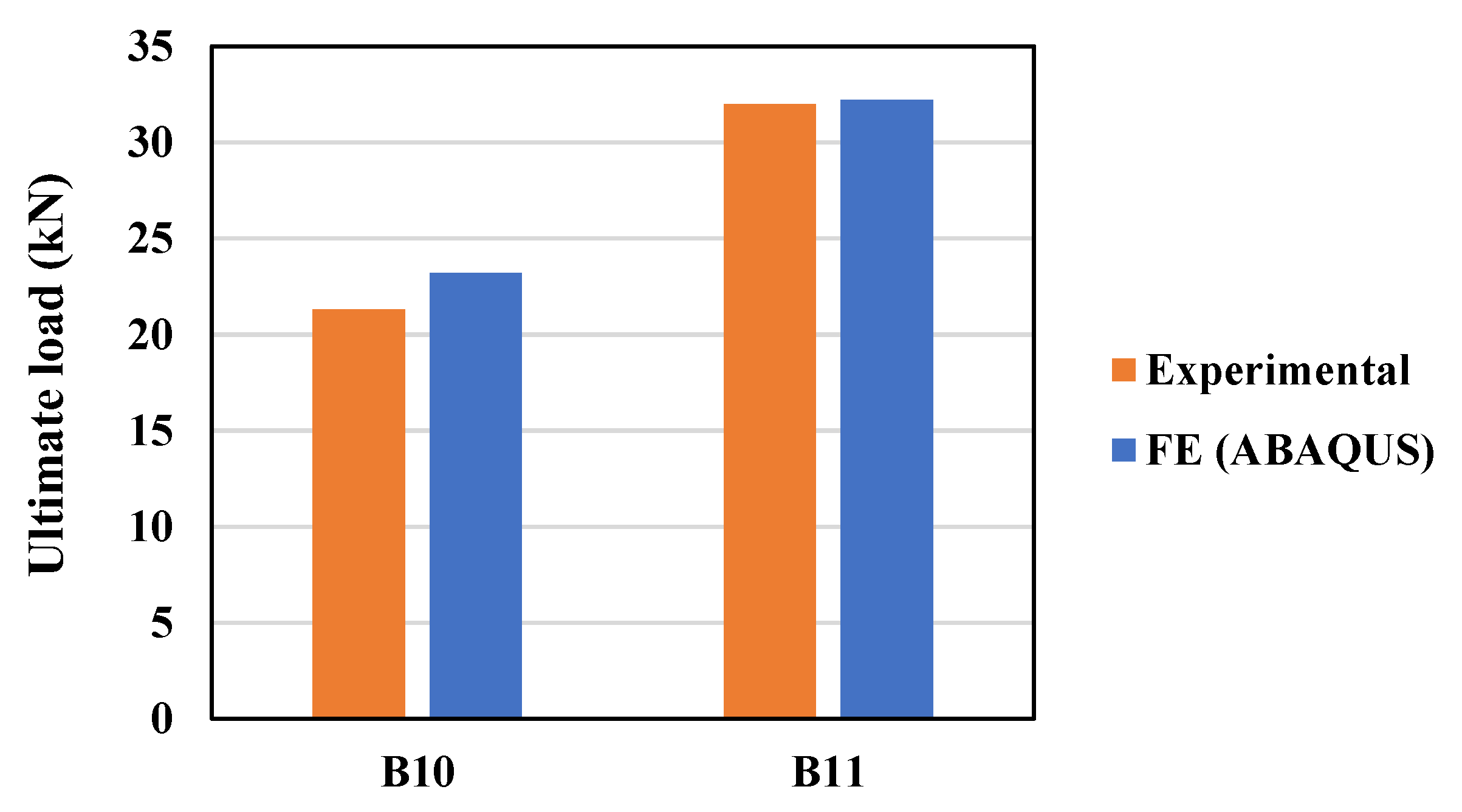


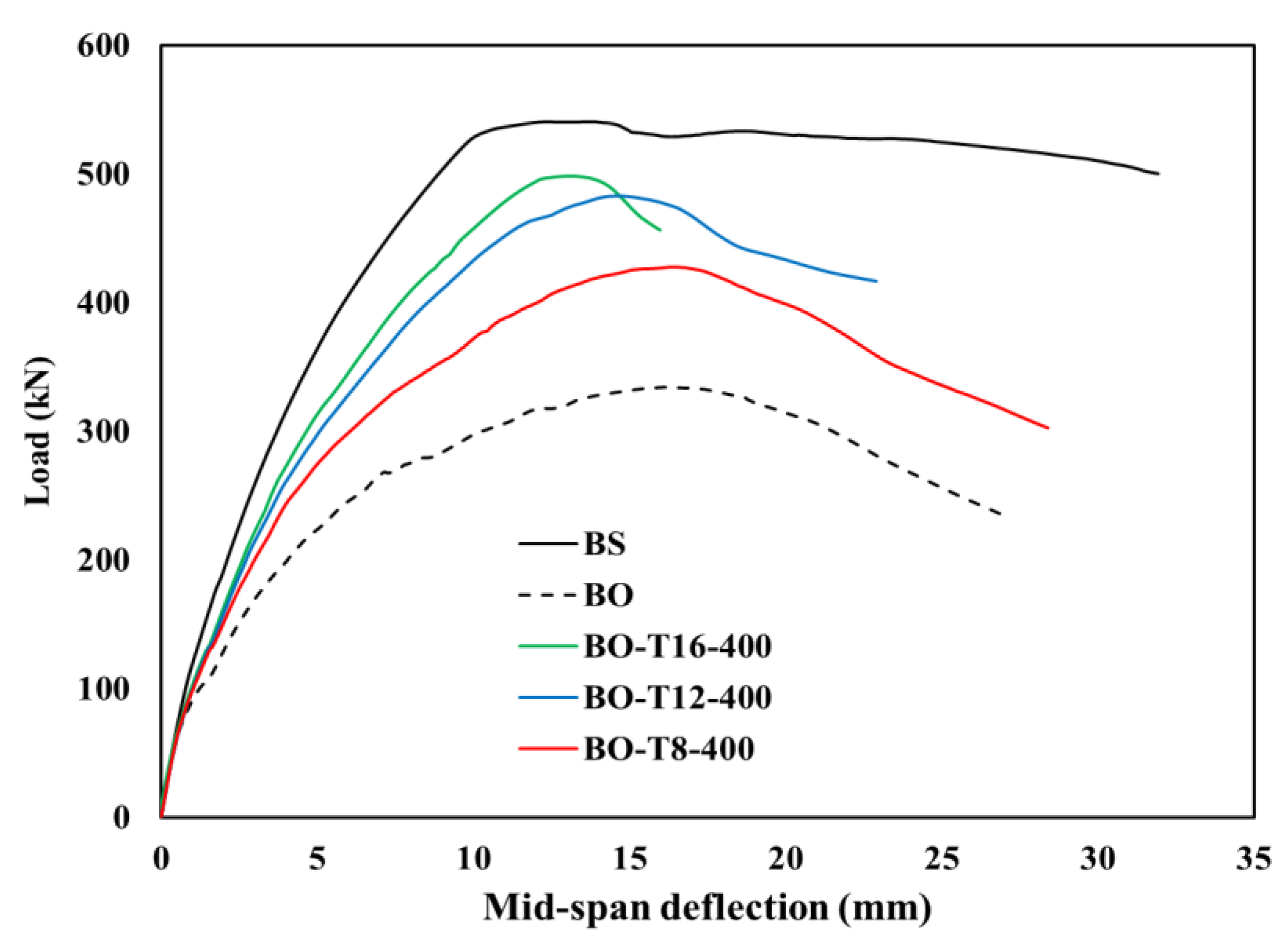
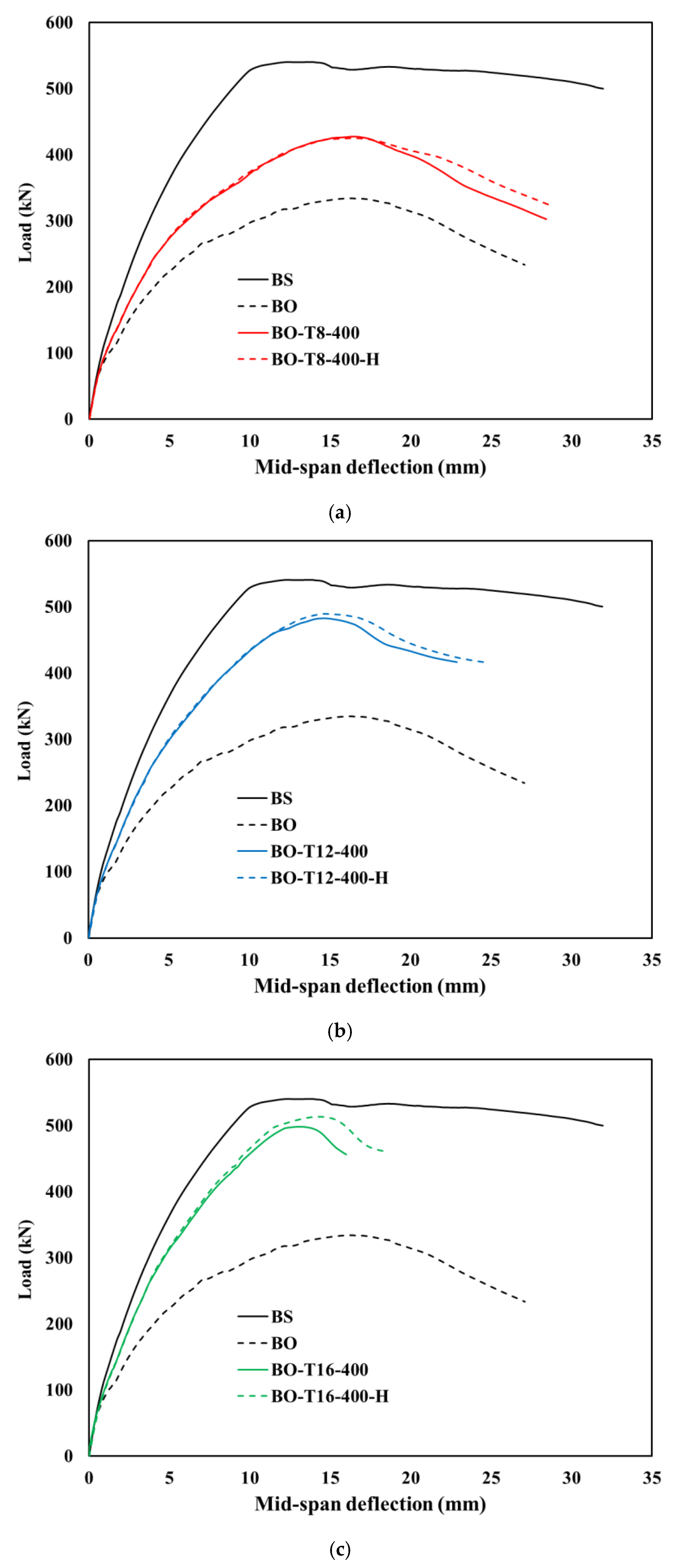
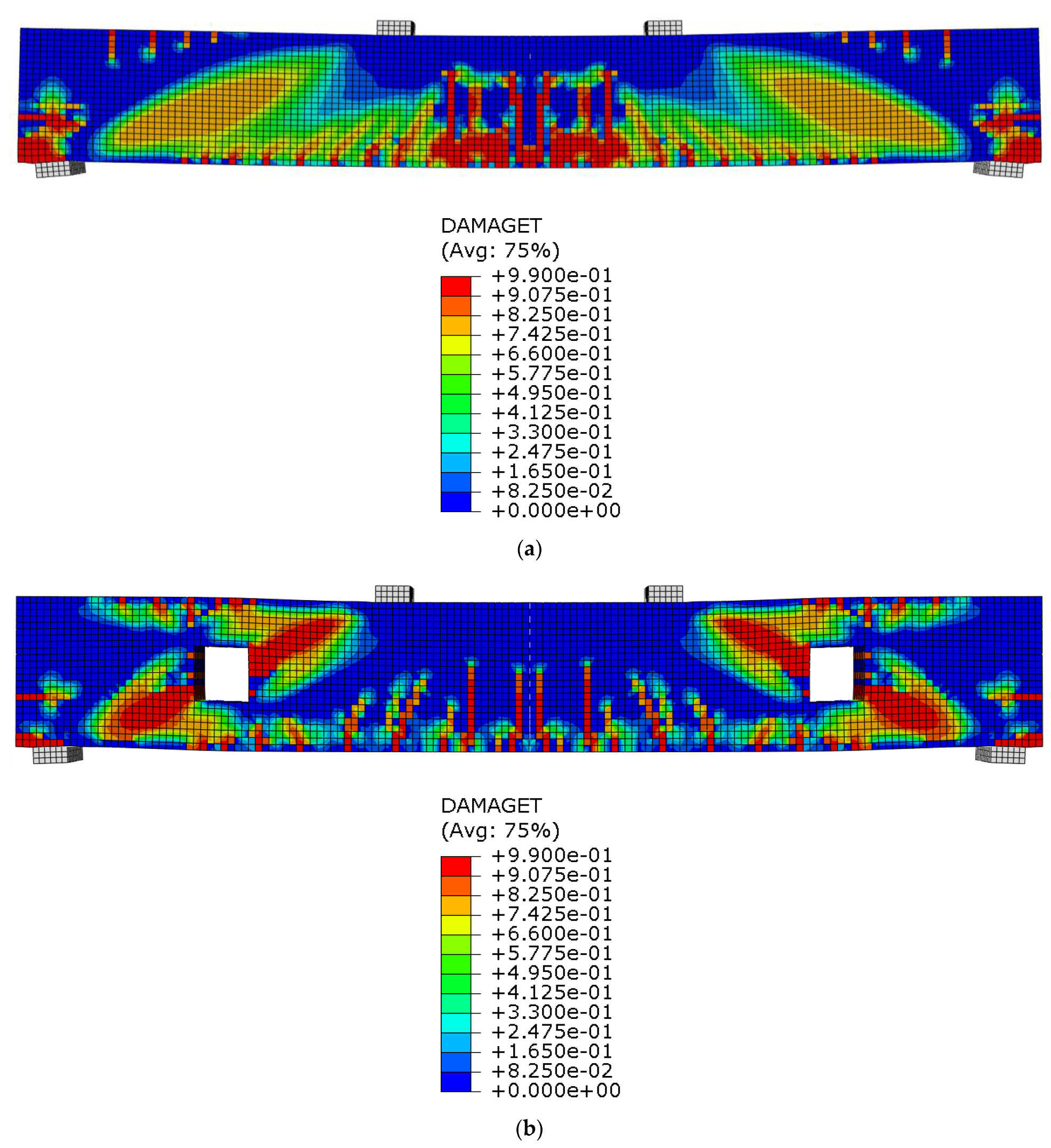
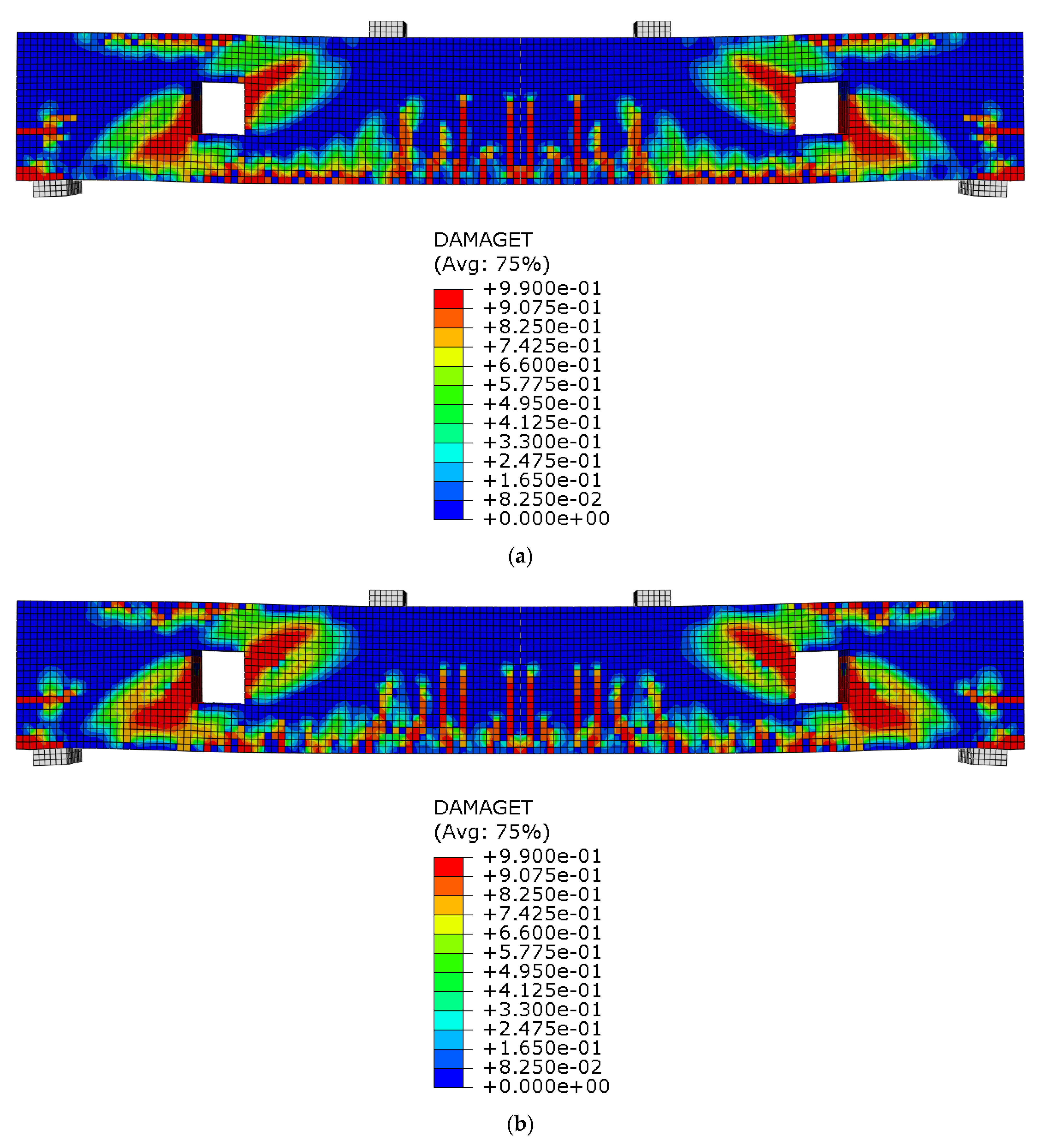
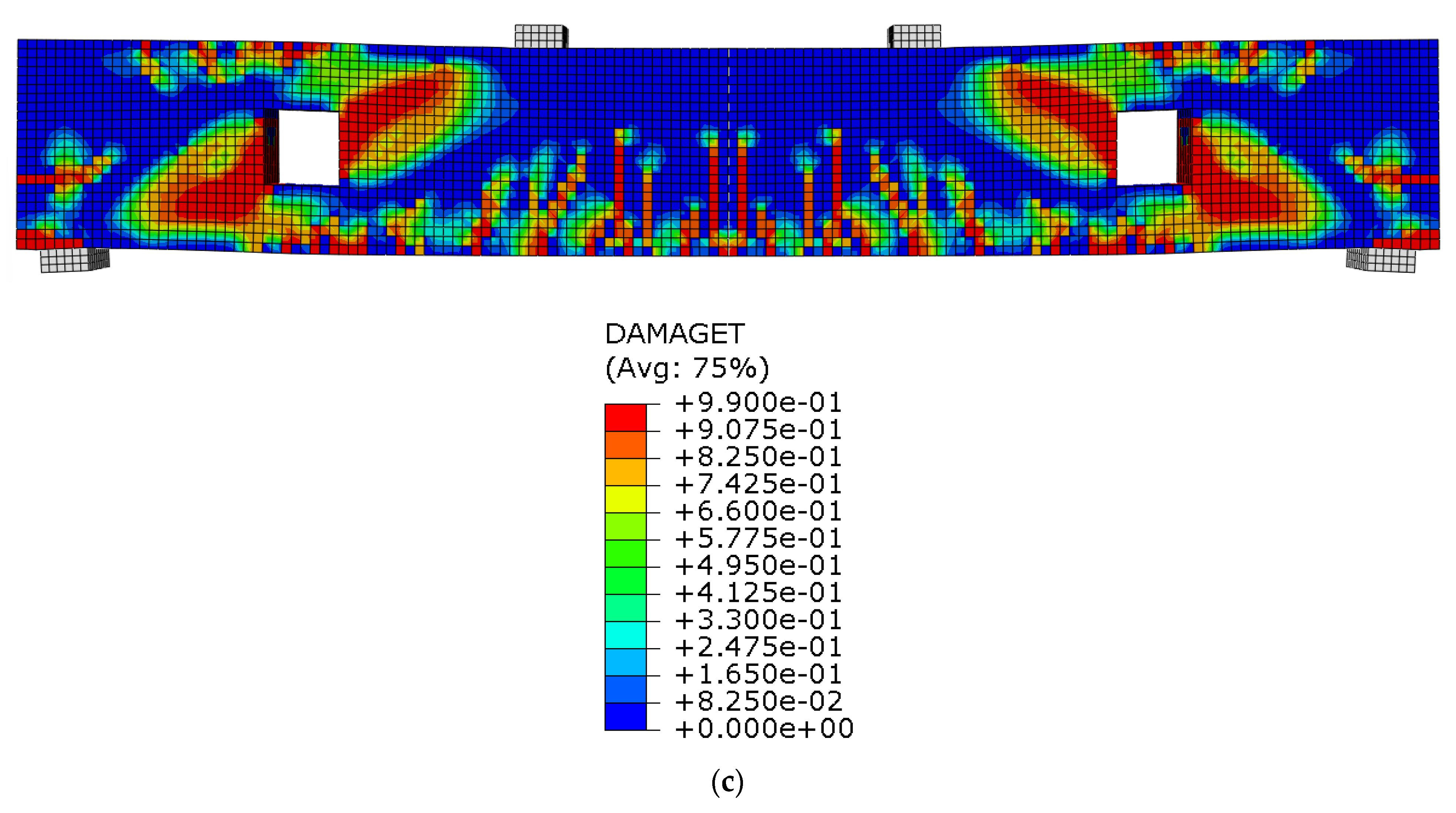
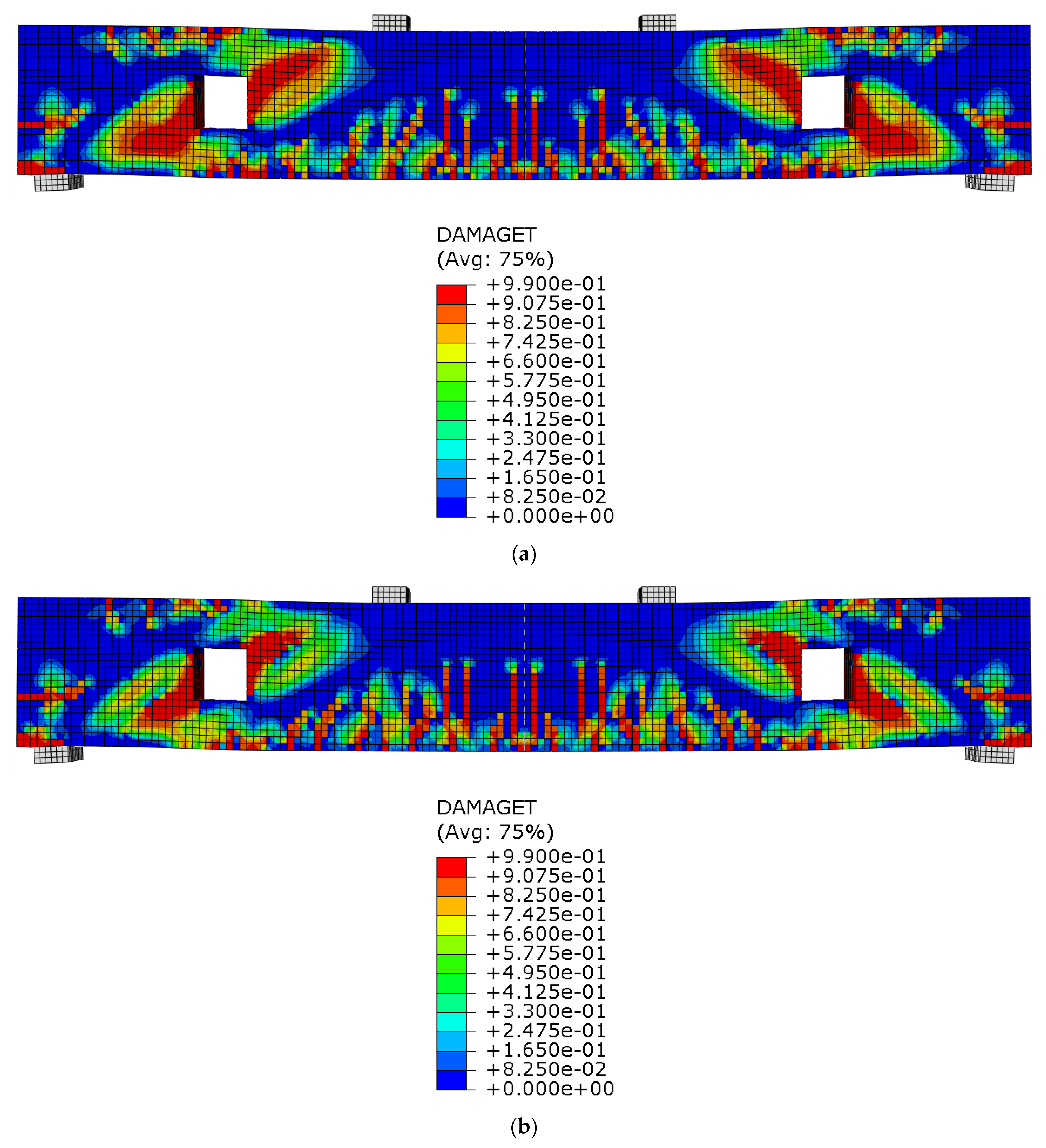



| Damage Parameters [58] | |||||
|---|---|---|---|---|---|
| φ | e | fb0/fc0 | K | µ | |
| 55 | 0.1 | 1.16 | 0.67 | 0.0001 | |
| Compressive Stress–Strain Models by Hsu and Hsu [64] | Tensile Stress–Crack Relations per CEB-FIP Code [65] | ||||
| Relationships | Output Parameter | Units | Relationships | Output Parameter | Units |
| Empirical stress–strain relationship | Unitless | Tensile strength | MPa | ||
| Normalized stress | Unitless | Tensile stress | MPa | ||
| Normalized strain | Unitless | Maximum crack opening | mm | ||
| Shape parameter | Unitless | Crack opening | mm | ||
| Peak strain | In/in | Fracture energy | N/mm | ||
| Initial tangential modulus | Kip/in2 |
Factor accounting for the maximum aggregate size (Dmax) | N/mm | ||
| Simplified shape parameter | Unitless | - | - | - | |
| Descending slope parameter | Unitless | - | - | - | |
| Maximum strain | In/in | - | - | - | |
| Group | Beam ID | Spacing Between Fe-SMA Stirrups | Fe-SMA Stirrups Diameter | Horizontal Reinf. | Studied Parameter |
|---|---|---|---|---|---|
| Control | BC | - | - | - | - |
| BO | - | - | - | - | |
| (I) | BO-T8-400 | 400 mm | 8 mm | - | Effect of sspacing between Fe-SMA stirrups |
| BO-T8-200 | 200 mm | 8 mm | - | ||
| BO-T8-100 | 100 mm | 8 mm | - | ||
| (II) | BO-T8-400 | 400 mm | 8 mm | - | Effect of Fe-SMA stirrups diameter |
| BO-T12-400 | 400 mm | 12 mm | - | ||
| BO-T16-400 | 400 mm | 16 mm | - | ||
| (III) | BO-T8-400-H | 400 mm | 8 mm | Yes | Effect of horizontal reinf. |
| BO-T12-400-H | 400 mm | 12 mm | Yes | ||
| BO-T16-400-H | 400 mm | 16 mm | Yes |
Disclaimer/Publisher’s Note: The statements, opinions and data contained in all publications are solely those of the individual author(s) and contributor(s) and not of MDPI and/or the editor(s). MDPI and/or the editor(s) disclaim responsibility for any injury to people or property resulting from any ideas, methods, instructions or products referred to in the content. |
© 2025 by the authors. Licensee MDPI, Basel, Switzerland. This article is an open access article distributed under the terms and conditions of the Creative Commons Attribution (CC BY) license (https://creativecommons.org/licenses/by/4.0/).
Share and Cite
Elkafrawy, M.; Khalil, A.; Hawileh, R.; AlHamaydeh, M. Numerical Study on Shear-Oriented Parameters in RC Beams with Openings Reinforced by Fe-SMA Rebars. Buildings 2025, 15, 2028. https://doi.org/10.3390/buildings15122028
Elkafrawy M, Khalil A, Hawileh R, AlHamaydeh M. Numerical Study on Shear-Oriented Parameters in RC Beams with Openings Reinforced by Fe-SMA Rebars. Buildings. 2025; 15(12):2028. https://doi.org/10.3390/buildings15122028
Chicago/Turabian StyleElkafrawy, Mohamed, Ahmed Khalil, Rami Hawileh, and Mohammad AlHamaydeh. 2025. "Numerical Study on Shear-Oriented Parameters in RC Beams with Openings Reinforced by Fe-SMA Rebars" Buildings 15, no. 12: 2028. https://doi.org/10.3390/buildings15122028
APA StyleElkafrawy, M., Khalil, A., Hawileh, R., & AlHamaydeh, M. (2025). Numerical Study on Shear-Oriented Parameters in RC Beams with Openings Reinforced by Fe-SMA Rebars. Buildings, 15(12), 2028. https://doi.org/10.3390/buildings15122028









